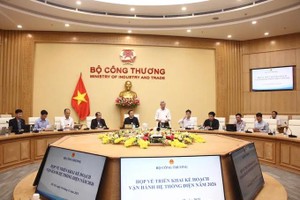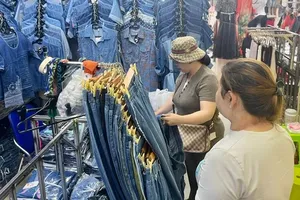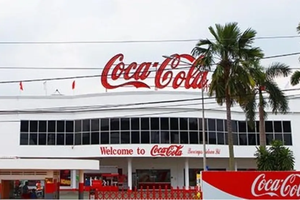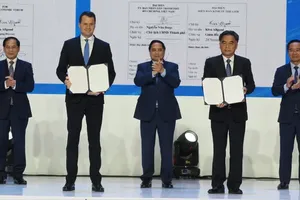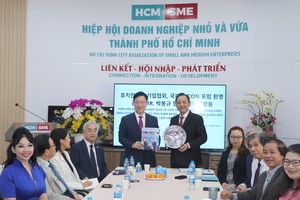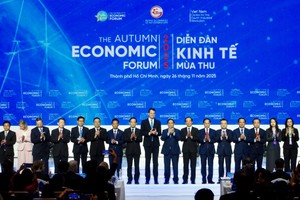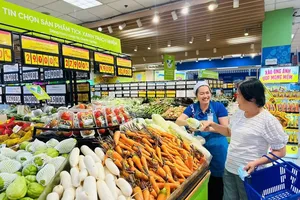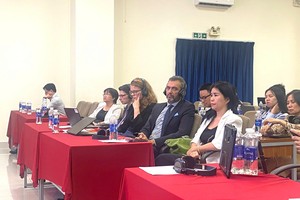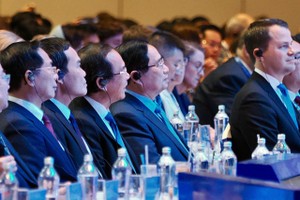The serious and unusual situation of the pandemic has caused people to tighten their spending, which seriously affected the consumption of construction materials in the country as well as for export. In Ho Chi Minh City, most of the construction material stores were still open even in the days when the whole country was implementing social isolation and distancing.
Ms. Tran Thi Men, the owner of Hoang Long Building Material Store in District 12, said that her store saw few footfalls although it has entered the construction season. During this time last year, she had to hire 4-5 workers to deliver building materials to customers. Now she only keeps one or two workers but the profit is not enough for her to pay rent and labor costs.
The consumption of construction steel products in the first months of this year merely reached around 60 percent of that in the same period last year and steel exports accounted for 70 percent. The domestic consumption of galvanized and color-coated steel sheet products nearly touched 70 percent and exports accounted for 60 percent; domestic consumption of cold-rolled coils was at 80 percent and exports were at 43 percent of that in the same period last year.
Similarly, the cement industry has been facing excessive supply, causing uncertainties to enterprises in the industry. According to the forecast by the Ministry of Construction, this year, the domestic demand for cement was estimated to increase by 4-5 percent compared to last year. However, the current outbreak of the novel coronavirus and natural disasters will affect greatly the income of people so the demand for housing will decline shortly.
As for export, in the first three months of this year, cement exports plunged sharply to roughly 7.5 million tons, worth US$291 million, accounting for 60.2 percent in volume and 80.8 percent in value compared to the same period last year. Chairman of the Vietnam Cement Association Nguyen Quang Cung said that the industry only suffers short-term difficulties as many construction projects have been delayed or extended. Hopefully, when the disease is controlled, investment activities in construction return to normal, the demand for cement will recover.
To prepare well for their recovery plans, some building material enterprises have been actively investing in technology, improve quality, and diversify products. FLC Stone Group has promptly equipped with a modern, closed production technology system from exploiting, producing, distributing, completing, and finishing natural stone products in Vietnam. Together with two stone factories with a capacity of more than 4,000 cubic meters per year, it has helped the company to expand the market share and fortify its foothold in the market. Similarly, many other enterprises have strived to find new directions, such as developing ultralight materials, applying new generation production technology with many outstanding features.
The representative of Vietnam Cement Corporation (Vicem) said that to cope with the current situation, the company has stepped up the program to avoid waste. Vicem’s subsidiaries strive to save 5 percent of management costs. In which, they promote research on low carbon clinker production to reduce carbon dioxide emissions and dust, and save non-renewable natural resources; at the same time, reduce the consumption of heat and electricity, and improve business efficiency.
Vietnam Steel Corporation (VNSteel) also said that the market has developed unfavorably, the production and business activities of some of its member companies only reached 23 percent of their monthly plans. To solve difficulties, the company has worked with the relevant authorities to resume import and export activities. At the same time, it has also looked for alternative sources of raw materials, such as coke imported by sea from Russia and Indonesia. The company also proposed solutions to support, delay, and extend tax payment for enterprises and speed up trade promotion to seek new markets.
Ms. Tran Thi Men, the owner of Hoang Long Building Material Store in District 12, said that her store saw few footfalls although it has entered the construction season. During this time last year, she had to hire 4-5 workers to deliver building materials to customers. Now she only keeps one or two workers but the profit is not enough for her to pay rent and labor costs.
The consumption of construction steel products in the first months of this year merely reached around 60 percent of that in the same period last year and steel exports accounted for 70 percent. The domestic consumption of galvanized and color-coated steel sheet products nearly touched 70 percent and exports accounted for 60 percent; domestic consumption of cold-rolled coils was at 80 percent and exports were at 43 percent of that in the same period last year.
Similarly, the cement industry has been facing excessive supply, causing uncertainties to enterprises in the industry. According to the forecast by the Ministry of Construction, this year, the domestic demand for cement was estimated to increase by 4-5 percent compared to last year. However, the current outbreak of the novel coronavirus and natural disasters will affect greatly the income of people so the demand for housing will decline shortly.
As for export, in the first three months of this year, cement exports plunged sharply to roughly 7.5 million tons, worth US$291 million, accounting for 60.2 percent in volume and 80.8 percent in value compared to the same period last year. Chairman of the Vietnam Cement Association Nguyen Quang Cung said that the industry only suffers short-term difficulties as many construction projects have been delayed or extended. Hopefully, when the disease is controlled, investment activities in construction return to normal, the demand for cement will recover.
To prepare well for their recovery plans, some building material enterprises have been actively investing in technology, improve quality, and diversify products. FLC Stone Group has promptly equipped with a modern, closed production technology system from exploiting, producing, distributing, completing, and finishing natural stone products in Vietnam. Together with two stone factories with a capacity of more than 4,000 cubic meters per year, it has helped the company to expand the market share and fortify its foothold in the market. Similarly, many other enterprises have strived to find new directions, such as developing ultralight materials, applying new generation production technology with many outstanding features.
The representative of Vietnam Cement Corporation (Vicem) said that to cope with the current situation, the company has stepped up the program to avoid waste. Vicem’s subsidiaries strive to save 5 percent of management costs. In which, they promote research on low carbon clinker production to reduce carbon dioxide emissions and dust, and save non-renewable natural resources; at the same time, reduce the consumption of heat and electricity, and improve business efficiency.
Vietnam Steel Corporation (VNSteel) also said that the market has developed unfavorably, the production and business activities of some of its member companies only reached 23 percent of their monthly plans. To solve difficulties, the company has worked with the relevant authorities to resume import and export activities. At the same time, it has also looked for alternative sources of raw materials, such as coke imported by sea from Russia and Indonesia. The company also proposed solutions to support, delay, and extend tax payment for enterprises and speed up trade promotion to seek new markets.

